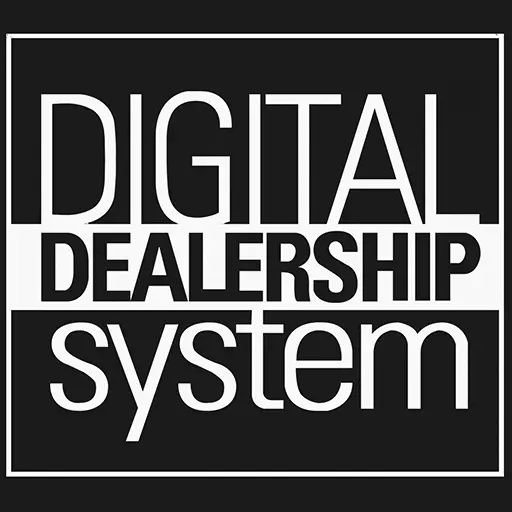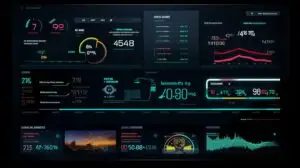The automotive industry is evolving rapidly, and for many dealerships, keeping track of Business Development Center (BDC) sales performance has become a major challenge. Did you know that mastering inbound and outbound activity can dramatically boost your conversion rates? This blog post aims to demystify the world of digital BDC sales performance tracking, offering practical tips on modern tools and strategies to improve customer experience and team productivity.
Ready for an upgrade? Let’s dive in!
Table of Contents
ToggleKey Takeaways
- BDC (Business Development Center) sales performance tracking involves monitoring both inbound and outbound activities in the automotive dealership to gauge effectiveness in converting customers.
- Mastering inbound and outbound activity improves customer experience and increases conversion rates, ultimately driving dealership growth.
- Digital tools like virtual training solutions, interactive performance metrics, and digital sign performance tracking are essential for effective BDC sales performance tracking.
- Benefits of digital BDC sales tracking include centralized data collection, increased efficiency and productivity, and staff motivation & retention.
Understanding BDC Sales Performance Tracking
![]()
BDC (Business Development Center) sales performance tracking presents a strategic approach to gauge the effectiveness of automotive dealership staff in converting customers. It mainly involves monitoring both inbound and outbound activities that contribute to dealership growth.
A central component is lead management, which entails tracking inbound leads from various platforms like dealer websites and measuring how effectively they are converted into sales by BDC agents.
Equally critical is keeping tabs on outbound calls aimed at owner marketing or ‘Be-Back calls’ targeting previous customers.
Using business intelligence tools, data collected from these activities can be analyzed and interpreted to provide insights into aspects such as closing percentages, productivity rate, and labor costs, among others.
This consequently influences decisions made regarding areas like operational efficiency process management and compensation plans for BDC agents. Digital retailing has also integrated with the BDC operations, providing an avenue for Internet sales via digital voice assistants and online shopping carts on dealers’ websites,, intensifying the need for efficient BDC sales performance tracking even more.
The Importance of Mastering Inbound and Outbound Activity

Mastering inbound and outbound activity is crucial for automotive dealership staff as it improves customer experience and helps convert more customers.
Improving Customer Experience
Mastering inbound and outbound activities in automotive dealerships is critical to enhancing customer experience.
As they navigate conversations with current or potential customers using modern retail management techniques, they enhance caller experience significantly. From CRM discussions to solving frequently asked questions on dealer websites – every interaction strengthens the customer-centric culture within the dealership network, leading to improved overall Customer Experience Excellence.
Converting More Customers
Mastering both inbound and outbound activity in your BDC operations is a proven strategy to convert more customers. This involves striking the right balance between handling incoming leads and actively reaching out to potential customers.
By leveraging modern techniques, such as customer-centric focus, communication skills, and digital marketing strategies, automotive dealership staff can significantly increase closing percentages.
Using tools like CRM (Customer Relationship Management) for lead management enhances operational efficiency while ensuring a seamless automotive digital retailing process for the customers.
This comprehensive approach ultimately drives dealership growth by effectively converting inquiries into confirmed sales.
Digital Tools for Tracking BDC Sales Performance

Digital tools are essential for tracking BDC sales performance, including virtual training solutions, interactive performance metrics, and digital sign performance tracking.
Virtual Training Solutions
Digital Dealership System offers Customer Training as part of their digital tools for tracking BDC sales performance. The courses are designed to be engaging, interactive, and impactful.
Automotive dealership staff can participate in these virtual training sessions to develop customer-centric skills and techniques. The training provides tools and techniques that can be implemented and reinforced at the dealership, enhancing overall performance.
Interactive Performance Metrics
Interactive performance metrics are digital tools that allow dealerships to track and measure the effectiveness of their BDC sales team. These metrics provide real-time data on key performance indicators, such as call volume, appointment set rates, and customer satisfaction scores.
By using interactive performance metrics, dealerships can identify areas of improvement for their BDC agents and make data-driven decisions to optimize their inbound and outbound activities.
These metrics also help in setting benchmarks for success and tracking progress toward those goals. Overall, interactive performance metrics enable dealerships to gain valuable insights into their sales processes and drive continuous improvement in their BDC sales performance.
Digital Sign Performance Tracking
Digital Sign Performance Tracking is a valuable tool for monitoring and improving the effectiveness of digital signage in BDC sales. By tracking key performance metrics such as viewer engagement, click-through rates, and conversions, dealerships can gain insights into how well their digital signs are performing and make data-driven decisions to optimize their messaging and placement.
With this information, dealerships can enhance the customer experience by delivering relevant content at the right time and place, ultimately leading to higher conversion rates and increased sales.
The Benefits of Digital BDC Sales Tracking
![]()
Discover the benefits of using digital BDC sales tracking for your dealership. It simplifies data collection, boosts efficiency and productivity, and keeps your staff motivated and retained.
See how these advantages can bring a fresh approach to managing and optimizing your sales processes. From gathering data in one place for clearer insights to improving overall efficiency with digital tracking, experience a significant change in how your dealership competes.
Notice the positive impact on staff motivation and retention as your team engages with a more dynamic sales tracking system. Uncover the potential of digital BDC sales tracking to revolutionize your dealership’s operations and achieve unparalleled success in the automotive industry.
Centralized Data Collection
Implementing centralized data collection is essential for effective digital BDC sales performance tracking. With a centralized system, all relevant data and metrics can be collected in one place, providing a comprehensive view of performance across different channels and activities.
This allows automotive dealership staff to easily track their progress, identify areas for improvement, and make data-driven decisions to optimize their sales strategies. Centralized data collection also enables management to gain insights into overall team performance and identify top performers or areas for additional training.
By having access to accurate and up-to-date information, dealerships can enhance their efficiency and productivity, and ultimately drive more successful outcomes in the highly competitive automotive industry.
Increased Efficiency and Productivity
Implementing digital BDC sales tracking tools can greatly increase efficiency and productivity within an automotive dealership. With centralized data collection, staff members can easily access and analyze customer information, leading to quicker response times and more personalized interactions.
This streamlined process eliminates the need for manual data entry and reduces the risk of errors.
Digital tools also provide interactive performance metrics that allow managers to track individual and team progress in real-time. By identifying areas for improvement, managers can provide targeted training and support to boost performance.
Digital sign performance tracking enables dealerships to monitor key metrics such as conversion rates and appointment bookings, giving them valuable insights into their overall sales effectiveness.
Leveraging digital BDC sales tracking tools leads to increased efficiency by eliminating time-consuming manual processes, improving decision-making through real-time data analysis, and optimizing performance through targeted training.
Staff Motivation & Retention
An important aspect of digital BDC sales performance tracking is staff motivation and retention. By implementing effective training programs and utilizing data-driven decision making, dealerships can increase employee satisfaction and reduce turnover.
With a focus on customer-centric skills and techniques, these training programs not only improve sales performance but also create a positive work environment that encourages employee satisfaction and loyalty.
Common Challenges in BDC Sales Performance Tracking
The traditional lecture-based learning approach poses a challenge in BDC sales performance tracking.
Traditional Lecture-Based Learning
Traditional lecture-based learning is often associated with common challenges in BDC sales performance tracking within the automotive industry. This outdated approach to training and development fails to engage employees fully and can be ineffective in driving measurable results.
In an ever-evolving digital landscape, dealerships need modern techniques that effectively track and improve sales performance. By implementing innovative tools and strategies, such as virtual training solutions and interactive performance metrics, dealerships can overcome these challenges and optimize their BDC’s inbound and outbound activity.
Balancing Inbound and Outbound Activities
Balancing inbound and outbound activities is a critical aspect of BDC sales performance tracking. Inbound activities involve responding to leads and inquiries that come in through various channels, such as phone calls, emails, or website forms.
Outbound activities, on the other hand, involve proactive outreach to potential customers through calls or emails.
Finding the right balance between these two types of activities is essential for maximizing conversions and optimizing productivity. Too much focus on inbound activities can result in missed opportunities for outreach, while too much emphasis on outbound efforts may lead to neglecting existing leads.
By measuring key metrics like contact rate, effective rate, productivity rate, and quality control, dealerships can identify areas where they need to improve their balance between inbound and outbound activities.
Technology Limitations
Technology limitations can pose challenges in tracking BDC sales performance. Outdated or inefficient technology can hinder accurate measurement and analysis of key metrics. This can result in incomplete or inaccurate data, making it difficult to identify areas for improvement or measure the effectiveness of training programs.
Limited technology capabilities may prevent the implementation of advanced digital tools for tracking performance, such as interactive dashboards or virtual training solutions.
Overcoming these limitations requires investment in modern technology solutions that enable real-time data collection and analysis, providing dealerships with actionable insights to optimize their BDC sales performance.
Strategies for Overcoming Challenges
Implementing effective training programs, utilizing data-driven decision making, and incorporating on-screen digital performance tracking are essential strategies for overcoming challenges in BDC sales performance tracking.
Implementing Effective Training Programs
Implementing effective training programs is crucial for maximizing BDC sales performance tracking.
Their highly engaging and interactive courses provide tools and techniques for implementation and reinforcement back at the dealership. With Customer Training, dealerships can ensure their staff receives the necessary training to excel in both inbound and outbound activities.
This allows dealerships to track progress and make data-driven decisions for continuous improvement.
Utilizing Data-Driven Decision Making
Utilizing data-driven decision making is essential for optimizing BDC sales performance tracking. By analyzing and interpreting data, automotive dealerships can make informed decisions that drive their sales strategies forward.
Data provides valuable insights into customer behavior, preferences, and patterns, allowing dealerships to tailor their approach and improve overall performance. With the help of digital tools and technology, such as interactive performance metrics and virtual training solutions offered by companies like Digital Dealership System, dealerships can access real-time data on inbound and outbound activities.
This empowers them to identify areas for improvement, measure the effectiveness of different strategies, and adjust their approach accordingly. By embracing data-driven decision making in BDC sales tracking, automotive dealerships can enhance efficiency, increase conversion rates, and ultimately boost revenue opportunities in today’s competitive market.
On-Screen Digital Performance Tracking
On-screen digital performance tracking is a valuable tool for measuring and improving BDC sales performance. It allows dealership staff to track their inbound and outbound activities in real-time, providing immediate feedback on calls made, appointments set, and deals closed.
This technology enables managers to monitor the effectiveness of their team members, identify areas for improvement, and provide targeted coaching. With on-screen digital performance tracking, dealerships can ensure that their BDC agents are staying on track with their goals, maximizing productivity, and ultimately driving more sales.
Case Study: Successful BDC Sales Performance Tracking
– The system allowed them to track and measure both inbound and outbound activity effectively.
– They were able to improve the customer experience by analyzing call recordings and identifying areas for improvement.
– By tracking conversion rates, they were able to convert more customers and increase sales.
– The digital tools provided real-time performance metrics that helped the dealership make data-driven decisions.
– The centralized data collection allowed for better analysis of overall performance and identification of trends.
– With increased efficiency and productivity, the dealership was able to serve more customers in less time.
– Staff motivation and retention improved as employees had access to their own performance metrics and could track their progress.
Conclusion – BDC Sales Performance Tracking
Mastering inbound and outbound activity through digital BDC sales performance tracking is crucial for automotive dealerships to improve customer experience, convert more customers, and ultimately drive success.
By utilizing digital tools such as virtual training solutions, interactive performance metrics, and digital sign performance tracking, dealerships can centralize data collection, increase efficiency and productivity, and motivate and retain staff.
Despite common challenges in BDC sales performance tracking such as traditional lecture-based learning or technology limitations, implementing effective training programs, utilizing data-driven decision making, and leveraging on-screen digital performance tracking strategies can help overcome these obstacles.
With the right approach and tools in place, dealerships can achieve exceptional results in their sales efforts.
FAQs
1. What is digital BDC sales performance tracking?
Digital BDC sales performance tracking refers to the process of monitoring and analyzing the inbound and outbound activities of a digital Business Development Center (BDC) in order to evaluate its effectiveness and make data-driven decisions for improvement.
2. How can I track the inbound activity of my digital BDC?
Tracking the inbound activity of your digital BDC involves monitoring metrics such as lead volume, source attribution, response time, conversion rates, and customer satisfaction scores. This can be done using software tools that capture and analyze data from various channels like phone calls, emails, chat interactions, and website visits.
3. What are some key metrics to measure outbound activity in a digital BDC?
When measuring outbound activity in a digital BDC, important metrics to consider include the number of outbound calls made, call duration or talk time per call, appointment setting rates, follow-up success rates, and overall sales closing ratios. These metrics help assess the productivity and effectiveness of your team’s outbound efforts.
4. How can I use performance tracking data to improve my digital BDC’s results?
Performance tracking data provides valuable insights into your digital BDC’s strengths and areas for improvement. By analyzing trends and patterns in the data, you can identify bottlenecks or inefficiencies in processes, optimize lead generation strategies, refine training programs for sales representatives or agents resolving customer queries , enhance communication protocols with customers,and implement targeted coaching or mentoring initiatives to boost overall performance levels within your team.

Alexi Walters is a trailblazing technology journalist known for her insightful coverage of how tech shapes society. With a background in journalism and a passion for innovation, she breaks down complex topics into engaging, accessible stories. Her work focuses on the transformative power of technology in fields like education, healthcare, and environmental sustainability, often highlighting the empowerment of women through tech.
A frequent contributor to leading tech publications, Alexi also advocates for women in STEM and regularly speaks at events to inspire the next generation. Her voice brings a fresh, critical perspective to the world of tech journalism.






